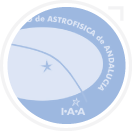Dust
Dust is always present in the Martian atmosphere, but its amount varies greatly depending on location and season. All dust observations show a seasonal pattern which is ruled by the occurrence of regional and global dust storms. The largest dust storms occur during southern hemisphere spring and summer when Mars orbits closer to the sun.
These events can grow to encircle completely the planet with dust optical depths largely exceeding unity. However, these events do not happen every Martian year, and they show significant variability in their timing and amplitude. Their triggering mechanisms remain largely unknown. On the other hand, regional dust storms occur every Martian year and last typically for a few weeks. Relatively low dust optical depth persists throughout most of the aphelion season with the exception of occasional small-scale dust storms at high latitudes along the edge of the retreating polar ice caps.

The two pictures shown here come from the E05 (June 2001) and E06 (July 2001) subphases of the MGS MOC Extended Mission. The view from June shows the Tharsis volcanic region (left), Valles Marineris chasms (right) and the late winter south polar cap (bottom). The view from July shows the same regions, but most of the details are hidden by dust storms and haze. Image Credit: NASA/JPL/Malin Space Science Systems
We aim at characterizing the regional and global dust storms on Mars in a global perspective, from the onset, to the expansion phase, and to the final decay phase. Therefore, we will develop a retrieval code for the self-consistent inversion of temperature vertical profiles, surface temperatures, and dust and ice integrated optical depths, and apply it to PFS LWC nadir measurements. We will further make use of both PFS and OMEGA data to detect and characterize origin, evolution, and properties of regional and local dust storms. By employing these observations and a GCM model, we will analyse impacts on the surface and atmospheric temperatures, as well as on the local, regional, and global circulation.
The effect of dust storm on water vapour and ice content will be also investigated, through retrieval and comparison of such quantities before, during, and after occurrences of dust storms. Outputs of this task will be provided to and as used in the parallel investigation of the water cycle.

In addition to the amount of dust suspended in the atmosphere, its vertical distribution plays an important role in the vertical distribution of solar energy in the atmosphere. Its sensitivity to many physical processes (i.e., transport, condensation microphysics, surface-atmosphere interaction, and photochemistry) provides constraints for a wide variety of models. Information on the aerosol vertical distribution has been obtained by SPICAM/MEx using stellar and solar occultations, and by limb observations by TES/MGS and MCS/MRO. These observations have shown the frequent presence of detached layers of putative water ice clouds superimposed on a background dust haze layer that varies in depth with season, and significant departures from a well-mixed dust vertical distribution during the northern spring and summer seasons in the tropics.
We propose to monitor aerosol distributions by employing OMEGA limb observations. Vertical profiles of aerosols properties (grains size distribution and number density of particles for each sounding atmospheric layer) can be retrieved from IR and near-IR spectra. For this purpose we will use the improved retrieval scheme including spherical geometry and multiple scattering, developed within UPWARDS. The quantitative analysis of the obtained distributions, with a particular emphasis on the mostly unknown boundary layer, will increase our understanding of the Martian atmosphere will improve the models’ skill to reconstruct the evolution of Martian climate.

Dust both absorbs and scatters UV radiation, being a key component in radiative transfer. However, the uncertainties affecting these processes make it difficult to isolate the dust contribution from that of the surface. Precise information on dust properties, such as size distribution, vertical structure, and UV single scattering albedo or phase function, is still lacking. Furthermore, a better knowledge of dust properties helps to increase the accuracy of the retrieval of other species like ozone or carbon dioxide. Information on the size and shape of dust aerosols can be obtained by analyzing the scattering of light by dust. But it is difficult to obtain information on the shape of the dust particles particularly because their exact composition is not known. The best method to derive any useful information is with near-IR or visible instruments that sample the scattering phase function using EPF from an orbiter.

MGS mapping of atmospheric dust in the IR (column opactiy at wave number 1075 cm-1) over three Martian years (Pankine et al., Icarus, Vol. 226, pp. 708-722, 2013). Global dust storms are typically initiated in the southern hemisphere during the perihelion season (Ls 180-360). They show a distribution very dependent on latitude and time, and have a frequency of about one every 3 years, for reasons not yet understood. This leads to an intense circulation and increased temperatures in the other hemisphere which, in turn, affects the water cycle and the formation of water ice clouds. The interrelated non-linear and global effects are thought to be behind the large and unpredictable Mars interannual variability. UPWARDS aims at studying these complex couplings between surface, atmosphere and radiation with all the data available so far and with new analysis tools.
Our goal is to improve the knowledge of dust optical properties by using cloud-free EPF measurements performed by both SPICAM/UV and CRISM. These observations allow us to derive different dust properties (altitude at which the dust is located, single scattering albedo, phase function). Cloud filtering will be performed on the basis of cloud data obtained during the water cycle analysis. The spectral and microphysical properties of dust and clouds derived from EPF observations will be included in the retrieval schemes to improve the determination of ozone from nadir observation performed by SPICAM/MEX ,and will be useful also for the analysis of nadir spectra from CRISM/MRO or from the future instrument NOMAD/UVIS on ExoMars TGO.
Dedicated Work Package: WP5
Links to other UPWARDS activities: WP1, WP3, WP4, WP7, WP8, WP9
Related Papers
Montmessin et al., Icarus, Vol. 183, pp. 403-410 (2006)
Määttänen et al., Icarus, Vol. 223, pp. 892-941 (2013)
Clancy et al., Icarus, Vol. 207, pp. 98-109 (2010)
Heavens et al., J. Geophys. Res., Vol. 116, E04003 (2011)
Montmessin et al., Icarus, Vol. 183, pp. 403-410 (2006)
Wolff et al., Icarus, Vol. 208, pp. 143-155 (2010)
































